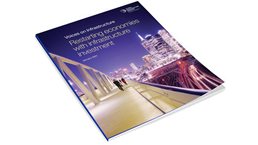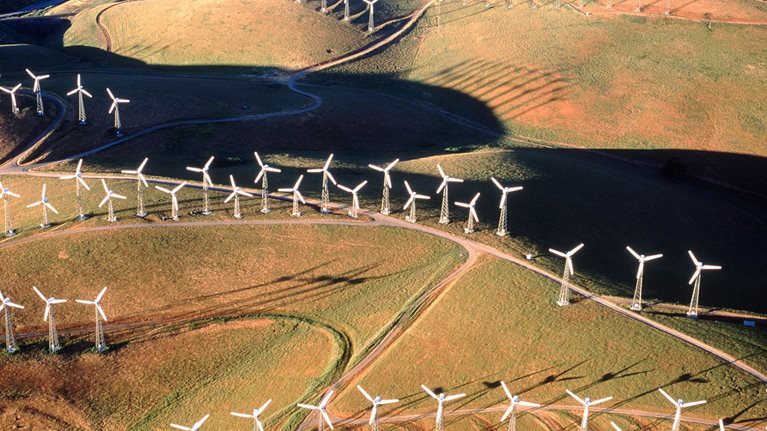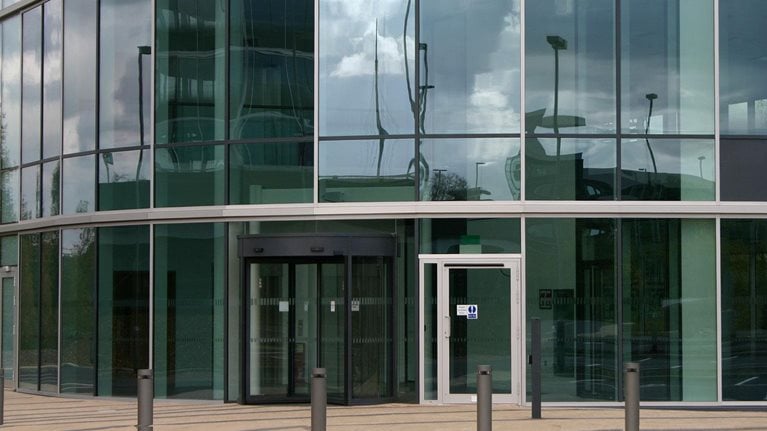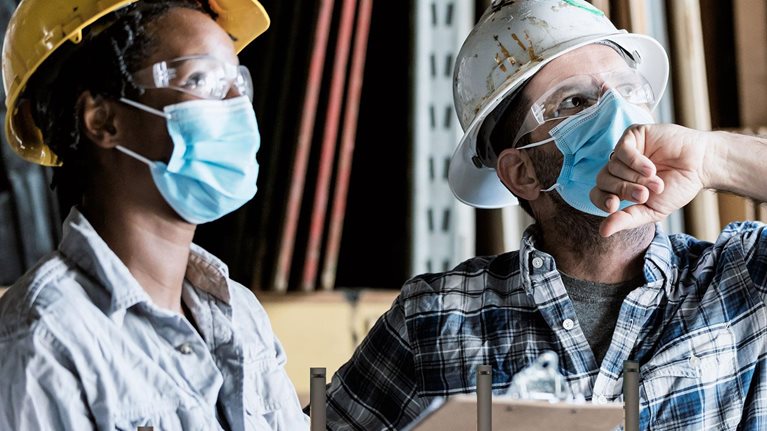Infrastructure investment has long been viewed as an important part of economic-crisis recovery because it creates jobs and revitalizes communities. It is already on the postCOVID-19 stimulus agenda. But is that the right approach, and how can governments ensure that investment actually pays off?
In 2017, the Brookings Institution hosted a debate between two Harvard economists about infrastructure’s role in long-term economic growth and how projects should be evaluated and funded. Several years later, in a pandemic-ravaged global economy, McKinsey asked Larry Summers and Ed Glaeser to weigh in again.
Motion
Increased federal infrastructure spending is necessary for post-COVID-19 economic recovery.
For: Larry Summers, President Emeritus and Charles W. Eliot Professor, Harvard University
Against: Ed Glaeser, Fred and Eleanor Glimp Professor of Economics, Harvard University
Opening statement
Larry Summers
I believe that infrastructure investment from both the public and the private sector, on the basis of careful analysis, has to be an important part of any post-COVID-19 economic recovery strategy. And this is an ideal time for increased federal spending on infrastructure—indeed, government borrowing costs are extremely low.
A striking feature of the current economic reality is what I’ve referred to as “secular stagnation.” Today’s extraordinarily low real interest rates are projected to persist; inflation is low and expected to remain low; projected growth is relatively slow; and unemployment is likely to remain abnormal. In the wake of the pandemic, the economy has excess capacity and the cost of labor is very low—much of the incremental labor will likely come from people who would otherwise be idle and collecting unemployment insurance.
This is coupled with abundant examples of inadequacies in our infrastructure:
- Vehicle repairs due to potholes in roads and highways are extremely costly for US drivers; a 2016 study found such repairs totaled $15 billion over five years.1
- Children in the United States have, in very recent times, been exposed to chemicals in their drinking water that have reduced their IQs.2
- The United States lags in digital access, which has been to the great detriment of many children during the COVID-19 period.
- We have an air traffic control system that at crucial moments relies on paper, thumbtacks, and oak boards. And, critically, a system that operates without GPS.
Investing in these areas would have great return, including social benefits, especially with costs as low as they are. We need to invest more and deploy infrastructure more wisely, procure it more efficiently, and site it more quickly. That will mean more and better infrastructure in the postCOVID-19 era.
Ed Glaeser
We agree on the value of infrastructure spending and that America deserves better infrastructure, but I don’t believe federal investment is critical for post-COVID-19 recovery. Seeing infrastructure as a counter-recessionary move stands in the way of taking the time and seriousness to think about doing infrastructure well. Rather, we should see it as a sensible investment for the future of this country.
I keenly believe that there is no area in which it is easier to waste tens of billions of dollars than infrastructure, which makes doing projects for the wrong reasons phenomenally costly. Detroit still watches the near-empty People Mover monorail glide over near-empty streets because someone in Washington thought that monorails would be the future. What Detroit’s children needed were safer streets and better schools.
The more that infrastructure investment is guided by delivering value to the users, as opposed to some other ephemeral aim such as putting people to work, the more likely it is that the benefits will exceed the costs. We should start by asking, “What do Americans need to move around?” It’s not high-speed rail in the American West. It’s likely to be smart ways of using new technology and similar initiatives that provide user value.
The user-fee funding model helps ensure projects are maximizing the benefits and minimizing the costs. Many forms of our infrastructure, such as airports, are used disproportionately by the richest Americans or the richest people throughout the globe. It cannot possibly make sense to tax the poor to subsidize the rich, particularly at a time when the pandemic-fueled crisis has widened the gaps between rich and poor. And it makes little sense to subsidize carbon-intensive activities, such as driving longer distances, at a time when we fear climate change.

Voices on Infrastructure: Restarting economies with infrastructure investment
Rebuttal
Larry Summers
Ed suggests that countercyclical infrastructure investment is likely to be a mistake. I disagree with him in two important respects. First, there’s much that can be done quickly. Our infrastructure is hugely undermaintained, and there’s no reason not to do a proportionate share of repairs at moments when labor is more available. It’s not smart to hastily build large and complex systems because of a temporary economic downturn, but there are substantial and straightforward repair opportunities.
Second, the secular stagnation argument suggests that, for the foreseeable future, capital costs are lower, and economic slack is likely to persist. That abets the opportunity cost of the labor that’s employed in infrastructure and lowers capital costs. Just as more people choose to build homes when interest rates are low, it is entirely appropriate that more public projects be undertaken when interest rates are low.
We could have a user-fee agenda for US infrastructure that is far more ambitious than the current one. Nonetheless, it is important to recognize that, particularly with respect to large infrastructure, there are vast externalities. Northern Virginia is a thriving area in the United States. It would not have happened without Dulles Airport, which many people believed for decades was a quintessential white elephant. That suggests that being overly risk averse is a mistake.
Subsidies exist, but we certainly should not have a principle that infrastructure has to pay for itself. I suspect that the New York City subway system paid for itself only very poorly for the generation after the tunnels were first dug, but it made possible today’s New York City. Visionary infrastructure ideas are worthy of government subsidy, including investments in clean, green technology. It would be a very serious error for us to leave that to the private sector. It is unlikely that we’ll make the right choices—for instance, in the twin revolutions of electric vehicles and self-driving vehicles—without a substantial public role.
Ed Glaeser
There are projects where private provision makes sense, but that does not exclude a public role. You actually need a stronger public sector to oversee private providers. And I agree there are some exceptions to the user-fee model. It’s entirely reasonable to think that we’re always going to subsidize those cases where infrastructure is very targeted to employment and access for poorer Americans, and I’m comfortable with that.
There are also creative configurations of the user-fee model, for cases when entities other than users benefit. In our previous debate, I referred to Hong Kong’s mass-transit example, which pays for its low-cost access to its trains by building large towers on top of those train stops. Some form of local property value capture is appropriate, especially when the cost of maintaining and operating an asset is close to the cost of using it.
The classic case against user-fee financing is that there are instances where the fixed cost is so high that the average cost of using the infrastructure is much greater than the marginal cost. Consequently, charging riders the marginal cost means that revenues are too low, and charging them the average cost can result in fewer riders. Those instances are rarer than they would seem. In the case of highways, the marginal cost of providing highway services, particularly for trucks, is actually not substantially lower than the average cost. The depreciation that large trucks cause on highways is large enough that, if you wanted to have them take on those costs, you could charge them at roughly the average cost.
I worry about the claims of widespread externalities from infrastructure. If we’re suggesting a subsidy for externality-based reasons, I want to know very clearly what those externalities are, and I want to be able to put a clear dollar number on it. Today’s low interest rates and low cost of labor would all be part of the cost-benefit analysis, of course, but the bigger question is whether you believe there’s some sort of large-scale macroeconomic effect that’s going to create value.
In terms of post-COVID-19 economic recovery, I’m concerned about place-based project selection. If you are designing an infrastructure program that’s supposed to aid in recovery, shouldn’t that go to hardest-hit regions, such as in eastern Kentucky or West Virginia? We have a good track record with the Appalachian Regional Commission and many infrastructure investments in declining places. Eastern Kentucky doesn’t need more highways. It needs better vocational training, better schools, more entrepreneurship, and a better-designed social safety net that does more to encourage work. Those are things the federal government can invest in.
Closing statement
Larry Summers
Ed and I agree you should do cost-benefit analyses around infrastructure projects. We also agree that there’s a tendency for advocates to overemphasize externalities. However, I think taking a narrow, financially centric view would have led to the rejections of the Interstate Highway System and the First Transcontinental Railroad, and it has indeed led to an air traffic control system that needs improvement.
Ed is right to distinguish between regional policy and infrastructure policy, and often the right policy for depressed regions—and those hit by the pandemic-fueled recession—does not primarily involve infrastructure. But infrastructure spending should be judged as an investment, and crucial parts of necessary infrastructure are typically in thriving areas.
And as I look at America’s problems, I do not think the principal problem—or even a terribly important problem—is that we have invested in too many white elephants or that we need better procedures to stop white elephants. The important problem is the task at hand: We need to enable a mid-21stcentury economy. And what better time than now—with high unemployment and epically low interest rates—to initiate a major effort in that direction and boost economic-recovery efforts.
Ed Glaeser
The question going forward is not how to have more or less infrastructure but how to have better infrastructure. That means taking on the challenges that Larry discussed—for instance, getting to an air traffic control system that’s actually effective. With pandemic-induced travel restrictions and physical-distancing requirements making it hard to send people to do infrastructure jobs, now is a great time for planning and rethinking infrastructure systems and envisioning a new and better public sector in the United States—one that delivers far more value for the dollars that we are spending.
Like Larry, I think it is an outrage that American children are unable to log into their classes right now and that there are people in Flint, Michigan who are poisoned by public water. It is vital that we make sure that this never happens again. It is also vital that we invest in infrastructure that is health-related, which will, crucially, help make sure that we are more protected against any future pandemics.
We agree the federal government needs to be engaged—and engaged mightily—with the prospect of creating better American infrastructure in the 21st century. A strategy that says we know exactly what to do—write bigger checks—is likely to be the last thing in the world that we need. It is vital that, before those checks are written, we have systems in place to make sure that the vision that Larry shared is one that actually will be turned into reality.


